

Module 1: Future farms
The Plant Challenge is about creating smart, sustainable ways to grow our food.
Let’s kick off with a whirlwind tour of some farms of the future. You’re also going to meet your ambassador, unpack your plant kit, form your rōpū (team), and prepare to plant your microgreens!
I wonder what a farm of the future looks like?
Meet your local heroes!
From farms in space to greenhouses in carparks, smart growers across the world are reimagining how we grow food and feed our communities in ways that are friendlier for the planet.
There are lots of reasons our growers are innovating and finding better ways to grow our food. Scientists predict we’ll need more food in the future, but we’ll have less room to grow it. Why do you think this is?
Let’s check in with our special Wonder Project Ambassador Soltice who will give you the full run down on the Plant Challenge.
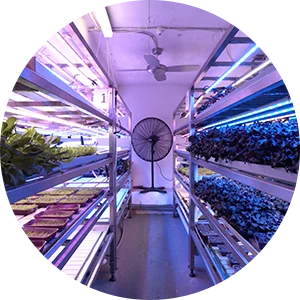
Get ready to grow
Over to you
Now, it's time for you to engineer your own sweet solution by developing a mini microgreen farm!
Over the course of the Plant Challenge, you’re going to grow two tasty microgreen trials, and set up the optimal environment to produce a thriving crop with your own grow houses.
To get you set up for success we’ll start by meeting your support crew, checking out your tool kit and sharpening up your STEM superpowers!
Meet your support crew
Your teacher and ambassador are here to support and guide you throughout the Plant Challenge. Say hi to your ambassadors and listen to their stories! If you don’t have an ambassador – no worries! Say hello to Soltice, who you met earlier in the module.

Unpack your plant kit
The Wonder Project has hooked you up with a plant kit which has everything you need to get started. Unpack your kit together as a class with your Wonder Project Ambassador and teacher. What do you think the different bits are for?
You’ll need to add a few more things for your Plant Challenge journey. Make a list of things you need to collect as a class to get prepared for the rest of the Challenge.
Use your STEM smarts
You’ll need to develop and use some special skills to tackle this challenge such as observation, teamwork, creativity, problem solving and communication. These are all skills that scientists, engineers and mathematicians use to solve problems and turn ideas into reality. We’ll help you master these throughout the challenge.
Smile for the camera
At the end of the challenge, your class will have the chance to make and share a short video of your Plant Challenge experience to be in to win a super sweet prize!
Make sure you’re documenting your Plant Challenge experience with heaps of videos and photos and start thinking about the story you want to tell.
How does food get to your table?
What's a carbon footprint?
Have you ever wondered how the food you eat gets onto your plate? Do you know what a ‘carbon footprint’ is?
A carbon footprint is the total amount of harmful greenhouse gases, such as carbon dioxide or methane, created by the products we use and the actions we take. When greenhouse gases are released into the atmosphere, it contributes to climate change. So, the smaller your footprint – the friendlier it is for the planet!
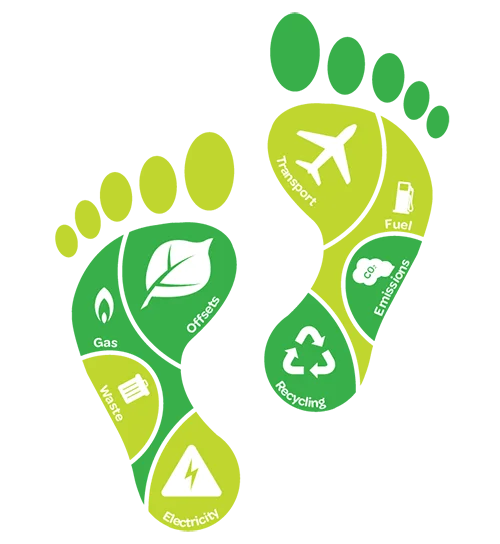
Food for thought
The way we grow, raise, make, move, eat, store, and waste our food has a huge impact on climate change. Globally, the food production cycle is responsible for about 25% of greenhouse gases released.
Food production cycle

Some foods use more fossil fuels, and therefore produce more greenhouse gases, than others. This means you can shrink your carbon footprint by choosing foods that are friendlier for the planet!
Lab 1.1: Carbon footprint champions
What you choose to eat can make a difference to climate change! Tap into your STEM superpowers to assess how carbon-friendly your lunch is. Then, figure out some ways to shrink it!
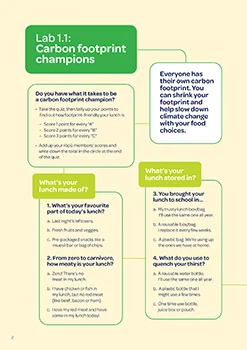
Carbon quiz reflection take home sheet
Challenge yourself to make your lunches more carbon friendly using the top tips in this take home sheet.
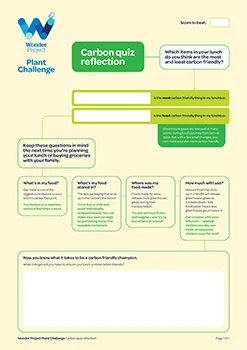
Explore and enhance our environment with technology
Environment exploration
Soon you’ll be growing your own sustainable microgreen crop in the classroom! Before you start you need to think about:
- What do plants need to grow?
- How does the environment affect growth?
- How can I create and measure the best environmental conditions for plant growth?
Use your sensors
We’ve given you some special sensor technology to help with your microgreen trials. Use these sensors to monitor the environmental conditions that affect your plant’s growth. By using your sensors to check these conditions you can engineer an environment where your microgreens will thrive!
These sensors measure:
- Temperature (how hot your growing environment is)
- Light (the amount of sunshine your greens get)
- Humidity (the level of water vapor in the air)
- Conductivity (whether or not your growing environment contains nutrients)

First, watch the video on how to use your sensors. Then we’re going to put them to the test by exploring our school environment in the sensor time trial.
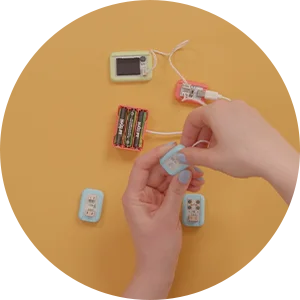
Using your five senses
You will also use your own inbuilt ‘sensors’ to observe, check and monitor your microgreen crops. You have five ‘senses’:
Can you think of an example of how you might use each one?
Lab 1.2: Sensor time trial
Take your curiosity outdoors and explore the environmental conditions around you using your sensors against the clock.
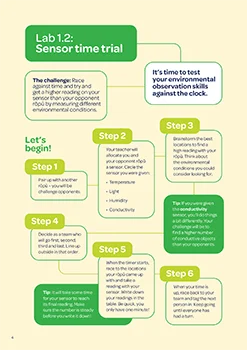
Reminder!
Collect containers and recyclables! You’ll need these for the next module.
Checklist
Mīharo! Today you:
- Learned all about future farms and sustainable food growth
- Explored carbon footprints
- Mastered the use of your sensors by testing environmental conditions